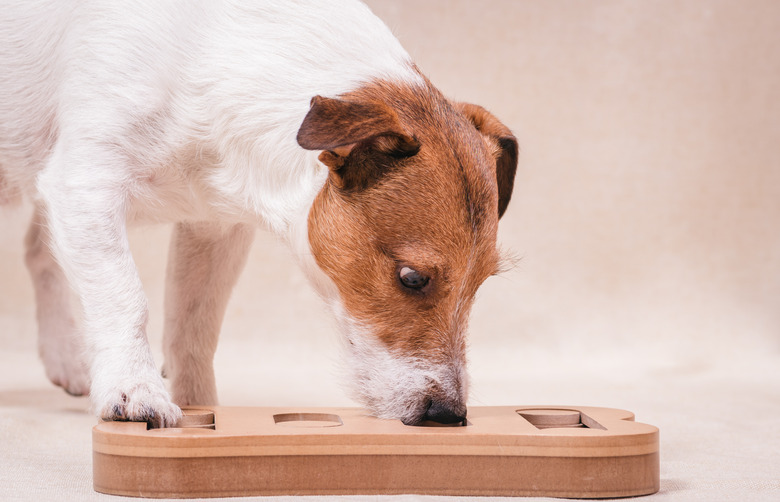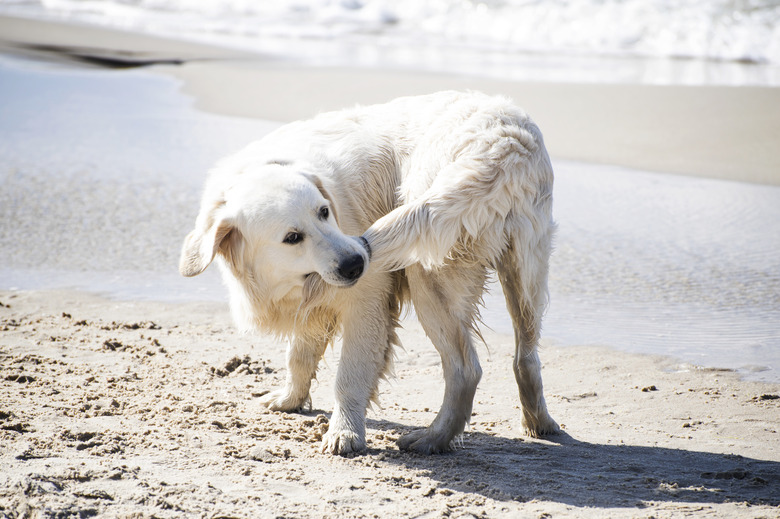Why Do Dogs Chase Their Tails?
Whether we've seen it in the movies or in our own back yard, we all have, at some point, encountered a dog chasing its tail. Tongue hanging out, full of insatiable energy, a dog loops around in circle after circle, trying to catch their tails. Round and round and round they go, why the do it, oh, wait, we maybe don't actually know.
Like other weird behaviors our dogs might do, understanding them will make us better pet owners. While it may be a behavior we look at as charming or silly from our dogs, it's actually important to understand why our dogs chase their tails. Because, while it's possible that tail chasing really is harmless, in some cases, it's a sign of deeper issues that need to be addressed.
Dogs might chase their dogs for play, but they might also be understimulated.
Dogs might chase their dogs for play, but they might also be understimulated.
There are a number of reasons that dogs chase their tales, but according to the VCA, in some it is just a harmless, playful behavior. Dogs need stimulation, so sometimes they chase their tales around and around both for exercise and fun. Dogs are social creatures, and they need playtime. Playtime with their humans or other pets helps to satisfy their emotional needs for companionship and bonding, while also providing exercise.
When they can't find social play, dogs might play by themselves, occasionally by chasing their tails. Solo play can be an important part of a dog's development, too. But if you notice your dog chasing their tails too often, consider giving them some variety—try puzzle toys or chew sticks that can stimulate their brain while they play. And at a certain point, a dog chasing their tail too often might be a sign of more than just their desire to play.
Repetitive behaviors like tail chasing could also be a sign of boredom or anxiety.
Repetitive behaviors like tail chasing could also be a sign of boredom or anxiety.
As responsible dog owners, it's important that we always pay close attention to our dogs' behaviors for signs of stress or other emotional issues. At a certain point, repetitive tail chasing can become a destructive behavior if your dog does it all the time. It may be a sign that your dog is bored or anxious. Also, look for signs of your dog catching its tail and chewing on it, which can lead to rawness or sores.
When the goal is to reduce tail chasing, we humans may. not be aware that our own behavior may be reinforcing it. When your dog chases its tail, do you pay attention to your pup? Do you "oooh" and "awww" at how cute it is? No judgment, because it probably is really cute! However, reacting in a positive way to your dog going after its own tail may only make it want to repeat the behavior and get more attention. Even negative attention like scolding can be interpreted by your dog as attention, so if your dog has been chasing their tail a lot, look at how your behavior may be encouraging it.
Tail chasing can also be the result of something more serious.
Tail chasing can also be the result of something more serious.
A good rule of thumb always when it comes to your four-legged family members: if it seems odd, talk to your vet. A dog suddenly becoming obsessed with their tail, chasing it or gnawing at it, could suggest something wrong with their tail. Maybe they hurt it or have a medical condition that's causing them discomfort. Talk to your vet especially if you notice a sudden change in behavior or behavior that seems alarming.
Sometimes, tail chasing can grow to the level of obsessive. It may be a sign that your pup is developing obsessive compulsive disorder. Similar to the disorder we understand in people, OCD can occur in dogs and usually manifests in the dog repeating normal behaviors to a compulsive degree. According to an article in Genome Biology, dog OCD behaviors do look slightly different than humans. "While typically in humans, these might be hand washing or cleaning, checking or hoarding, canine symptoms include repeated grooming, constantly chasing their own tails or shadows and suckling or blanket sucking."
OCD in dogs will need to be treated by a professional, because both dog and owner will need to work hard at behavior modification. But it's important to put in the work, because dogs with OCD can develop behaviors that can harm them. A dog might start chewing on their tail or licking at the same spot until it becomes damaged. You'll have to learn to identify things that trigger your pup's OCD, so you can help modify their behavior away from OCD behavior and into something more constructive.
Conclusion
Conclusion
If tail chasing is only an occasional behavior, there's probably no need to worry. If you notice your pup doing it all the time, try playing with them or offering them something to distract them. If the behavior becomes constant or is causing your dog harm, however, that's when you want to see advice from your vet. Because we all love when our dogs do something slightly weird and cute, but as always, our pet's physical and emotional health comes first.

